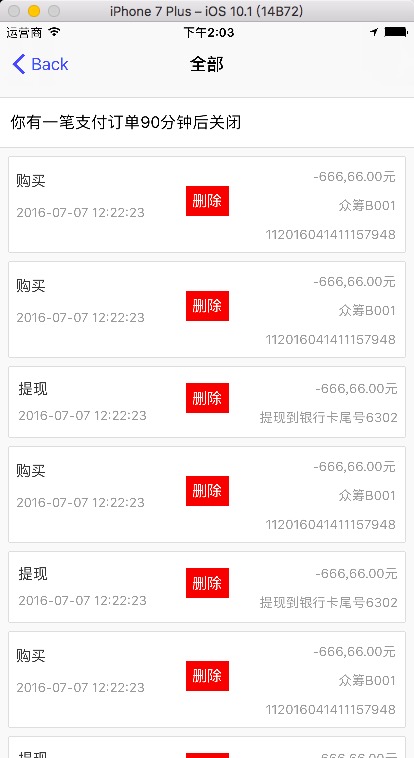使用 StoryBoard 制作一个能够删除cell的TableView
本篇博客方便自己检索使用。资源链接
下面是制作效果图,点击删除按钮,就能将该cell删除:

下面是主要的代码:
#define KSUPER_TAG 20000 #define KDEFAU_TAG 10000 #import "WholeViewController.h" #import "HJ_CELL_3.h" #import "HJ_CELL_4.h" #import "NULL_CELL.h" #import "HRAdView.h" #import "FrameMacro.h" #import "ColorMacro.h" #import "FontMacro.h" @interface WholeViewController () { NSMutableArray *_dataSource; UIView * _tabHead_View ; } @end @implementation WholeViewController - (void)viewDidLoad { [super viewDidLoad]; [self setTitle:@"全部"]; self.tableView.backgroundColor = K_SET_COLOR_VALUE(K_ROOT_BGC); // 假设有表头数据 [self createTableHeader]; // 设置无选择线 [self.tableView setSeparatorStyle:UITableViewCellSeparatorStyleNone]; self.tableView.showsHorizontalScrollIndicator = NO; self.tableView.showsVerticalScrollIndicator = NO; // 初始化数据源 _dataSource = [NSMutableArray arrayWithObjects:@"3",@"3",@"2",@"3",@"2",@"3",@"2",@"3",@"2",@"3",@"2",@"3",@"2",@"3",@"2",@"3",@"2",@"0", nil]; } // 创建表头 - (void)createTableHeader{ if (!_tabHead_View) { // 表头部分的View _tabHead_View = [[UIView alloc] initWithFrame:CGRectMake(50,50, K_WIDTH, 62)]; _tabHead_View.backgroundColor = K_SET_COLOR_VALUE(K_ROOT_BGC); // 初始化广告控件 HRAdView *hdview = [[HRAdView alloc] initWithTitles:@[@"你有一笔支付订单30分钟后关闭",@"你有一笔支付订单60分钟后关闭",@"你有一笔支付订单90分钟后关闭"]]; hdview.time = 2; [hdview beginScroll]; hdview.backgroundColor = [UIColor whiteColor]; hdview.isHaveTouchEvent = YES; hdview.clickAdBlock = ^(NSUInteger index){ NSLog(@"下标是 %ld",(unsigned long)index); }; hdview.frame = CGRectMake(0, 12, K_WIDTH, 49); [_tabHead_View addSubview:hdview]; // 分割线 1 UIView *line_1 = [[UIView alloc] initWithFrame:CGRectMake(0, 11, K_WIDTH, 1)]; [line_1 setBackgroundColor:K_SET_COLOR_VALUE(@"#dbdbdb")]; [_tabHead_View addSubview:line_1]; // 分割线 2 UIView *line_2 = [[UIView alloc] initWithFrame:CGRectMake(0, 61, K_WIDTH, 1)]; [line_2 setBackgroundColor:K_SET_COLOR_VALUE(@"#dbdbdb")]; [_tabHead_View addSubview:line_2]; } self.tableView.tableHeaderView = _tabHead_View; } - (void)didReceiveMemoryWarning { [super didReceiveMemoryWarning]; if (self.isViewLoaded&&self.view.window) { self.view = nil; } } #pragma mark - Table view data source - (NSInteger)numberOfSectionsInTableView:(UITableView *)tableView { return 1; } - (NSInteger)tableView:(UITableView *)tableView numberOfRowsInSection:(NSInteger)section { return [_dataSource count]; } - (UITableViewCell *)tableView:(UITableView *)tableView cellForRowAtIndexPath:(NSIndexPath *)indexPath { UITableViewCell *cell = nil; NSString *mask = _dataSource[indexPath.row]; if ([mask isEqualToString:@"3"]) { cell = (HJ_CELL_3*)[tableView dequeueReusableCellWithIdentifier:@"HJ_CELL_3" forIndexPath:indexPath]; if (nil == cell) { cell = (HJ_CELL_3*)[[[NSBundle mainBundle] loadNibNamed:@"HJ_CELL_3" owner:self options:nil] lastObject]; } ((HJ_CELL_3*)cell).block = ^(NSInteger statusNum){ if ( 1 == statusNum) { // 执行删除任务 [self tableView:tableView commitEditingStyle:UITableViewCellEditingStyleDelete forRowAtIndexPath:indexPath]; } }; }else if ([mask isEqualToString:@"2"]) { cell = (HJ_CELL_4*)[tableView dequeueReusableCellWithIdentifier:@"HJ_CELL_4" forIndexPath:indexPath]; if (nil == cell) { cell = (HJ_CELL_4*)[[[NSBundle mainBundle] loadNibNamed:@"HJ_CELL_4" owner:self options:nil] lastObject]; } ((HJ_CELL_4*)cell).block = ^(NSInteger statusNum){ if ( 1 == statusNum) { // 执行删除任务 [self tableView:tableView commitEditingStyle:UITableViewCellEditingStyleDelete forRowAtIndexPath:indexPath]; } }; }else { cell = (NULL_CELL*)[tableView dequeueReusableCellWithIdentifier:@"NULL_CELL" forIndexPath:indexPath]; if (nil == cell) { cell = (NULL_CELL*)[[[NSBundle mainBundle] loadNibNamed:@"NULL_CELL" owner:self options:nil] lastObject]; } } return cell; } -(CGFloat)tableView:(UITableView *)tableView heightForRowAtIndexPath:(NSIndexPath *)indexPath{ NSString *mask = _dataSource[indexPath.row]; if ([mask isEqualToString:@"3"]) { return 105; }else if ([mask isEqualToString:@"2"]) { return 80; }else { return 20; } return 105; } // 删除某些行的方法 - (void)tableView:(UITableView *)tableView commitEditingStyle:(UITableViewCellEditingStyle)editingStyle forRowAtIndexPath:(NSIndexPath *)indexPath { if (editingStyle == UITableViewCellEditingStyleDelete) { // Delete the row from the data source [_dataSource removeObjectAtIndex:indexPath.row]; [tableView deleteRowsAtIndexPaths:@[indexPath] withRowAnimation:UITableViewRowAnimationFade]; [self.tableView reloadData]; } else if (editingStyle == UITableViewCellEditingStyleInsert) { // Create a new instance of the appropriate class, insert it into the array, and add a new row to the table view } } /* // Override to support rearranging the table view. - (void)tableView:(UITableView *)tableView moveRowAtIndexPath:(NSIndexPath *)fromIndexPath toIndexPath:(NSIndexPath *)toIndexPath { } */ /* // Override to support conditional rearranging of the table view. - (BOOL)tableView:(UITableView *)tableView canMoveRowAtIndexPath:(NSIndexPath *)indexPath { // Return NO if you do not want the item to be re-orderable. return YES; } */ /* #pragma mark - Navigation // In a storyboard-based application, you will often want to do a little preparation before navigation - (void)prepareForSegue:(UIStoryboardSegue *)segue sender:(id)sender { // Get the new view controller using [segue destinationViewController]. // Pass the selected object to the new view controller. } */ @end




